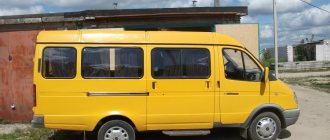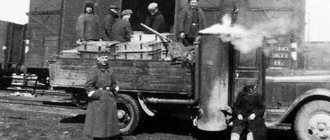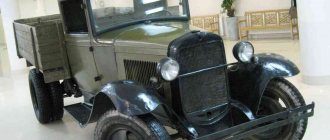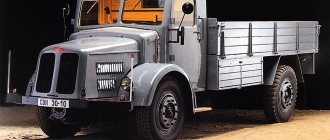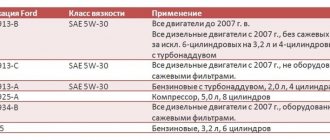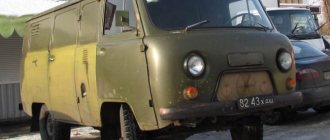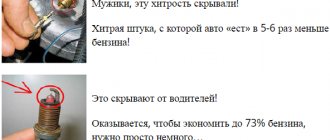| ZIS-150 | |||||||||||||||||||||||||||||||||
| Total information | |||||||||||||||||||||||||||||||||
| Years of production | 1947—1958 | ||||||||||||||||||||||||||||||||
| Assembly | ZIS (Moscow, USSR) ZIL (Moscow, USSR) | ||||||||||||||||||||||||||||||||
| Design | |||||||||||||||||||||||||||||||||
| Layout | front-engine, rear-wheel drive | ||||||||||||||||||||||||||||||||
| Engine | |||||||||||||||||||||||||||||||||
| |||||||||||||||||||||||||||||||||
| Transmission | |||||||||||||||||||||||||||||||||
| Type | mechanical | ||||||||||||||||||||||||||||||||
| Number of steps | 5 | ||||||||||||||||||||||||||||||||
| Gear ratios | |||||||||||||||||||||||||||||||||
| 1st gear | 6,24 | ||||||||||||||||||||||||||||||||
| 2nd gear | 3,32 | ||||||||||||||||||||||||||||||||
| 3rd gear | 1,898 | ||||||||||||||||||||||||||||||||
| 4th gear | 1,00 | ||||||||||||||||||||||||||||||||
| 5th gear | 0,81 | ||||||||||||||||||||||||||||||||
| Reverse gear | 6,70 | ||||||||||||||||||||||||||||||||
| Switching | floor lever | ||||||||||||||||||||||||||||||||
The main gear is double, the gear ratio is 7.63.
Characteristics Weight and dimensions Length 6720 mm Width 2470 mm Height 2180 mm Ground clearance 265 mm Wheelbase 4000 mm Rear track 1740 mm Front track 1700 mm Weight 3900 kg Dynamic Maximum speed 65 km/h On the market Other Load capacity 4000 kg Fuel consumption 29 l/100 km Volume tank 150 l← ZIS-5ZIL-164 →ZIS-150 on Wikimedia Commons
To improve this article it is desirable:
|
ZIS-150
(from June 26, 1956 -
ZIL-150
) - a Soviet truck produced between 1947 and 1957. In 1957, it was replaced by the ZIL-164 model, which was actually a modernized ZIS-150. 771,883 copies of all modifications were produced.
Model history
| This article or section contains a list of sources or external references, but the sources of individual statements remain unclear due to a lack of footnotes. Claims that are not supported by sources may be questioned and removed. You can improve the article by providing more accurate citations to your sources. |
ZIS-150 in the Moscow Museum of Retro Cars
The ZIS-150 truck was supposed to replace the ZIS-5 back in the late 1930s. In 1938, the Stalin Plant built prototypes of the truck, called ZIS-15. This car featured a three-seater all-metal cabin, a modernized 82-hp engine. s., new frame. However, the Great Patriotic War delayed the launch of the model into series for a long time. Only in 1944, at the Stalin Plant, new models of the truck were manufactured, designated ZIS-150, with a front end lining that looked very similar to the American International Harvester K-7.
On October 30, 1947, an installation batch of ZIS-150 trucks was produced. Since pre-war tests showed insufficient engine power, the power on the production car was increased to 95 hp. With. at 2800 rpm. In the design of the ZIS-150, for the first time in the history of the Soviet automobile industry, a five-speed gearbox with constant mesh gears and a pneumatic brake drive were used. Load capacity increased from three to four tons. The car received a new cabin (due to the large shortage [1] in the country of thin steel sheets, it was made of wood and metal: the front tail was made of steel, the doors were wooden) with an efficient heating system and roll-down door windows. The windshield consisted of two halves, the left half was made liftable: it was secured in any position using a rocker mechanism.
The plant completely switched to production of the new model on April 27, 1948, and before that, while a new conveyor was being installed in January 1948, production of the ZIS-5 continued (until April 30, 1948).
In 1950, the car underwent modernization: the carburetor and intake manifold were replaced, and the cabin became completely metal.
On August 18, 1951, production of an improved version of the car was also launched at the Kutaisi Automobile Plant under the KAZ-150 brand. About 80 changes were made to the design of the ZIS-150 at the Georgian plant, in particular, a rear axle from the ZIS-155 bus with an increased gear ratio (9.28 instead of 7.63) was installed, which made it possible to improve the traction qualities of the truck, intended for use by the main way in mountainous areas. Externally, the KAZ-150 differed from the ZIS-150 by a radiator grille with vertical bars and a different tail, partly reminiscent of the GAZ-51, partly of the UralZIS-355M. This was explained by the fact that the head of the design and experimental department of KAZ, A. M. Krieger, previously worked as deputy chief designer of GAZ. [ source not specified 1783 days
]
In February 1956, the ZIS-150 engine had its cast-iron cylinder head replaced with an aluminum one, which made it possible to increase the compression ratio to 6.2 and increase the output to 96 hp. With. power. Other changes include a new carburetor, intake manifold, air filter, reinforced frame, rubber front spring mounts, hydraulic shock absorbers. This modification was named ZIS-150V. Externally, it differed from the ZIS-150 by a radiator grille with vertical bars (not similar to the one that had been used on the ZIL-164 since 1957) and vertical blinds on the sides of the hood.
In June of the same year, after the 20th Congress of the CPSU, the Stalin Plant was renamed the Likhachev Plant. In this regard, at the end of production, some ZIS-150V vehicles received [2] hoods with new stamping “ZIL” instead of the previous “ZIS”.
This modernization was the last - in October 1957, the ZIL-150V gave way on the assembly line to the new model ZIL-164, which was very similar in appearance to the ZIL-150V, but differed in some technical innovations.
According to Soviet technical documentation and using production equipment received from the USSR, Romania and China also began producing their own ZIS-150. In Romania they began to make them under the brand name SR-101 (“Styagul Rosu” - “Red Banner”). The production of trucks here began in 1954 and continued until 1965 (54,224 units were produced; externally, Romanian trucks differed from Soviet ones in their bumper and rectangular cab). In China, in the city of Changchun, since 1956, the Jiefang CA-10 truck (“Jiefan” - “Liberation”) began to be produced by the “Automobile Plant No. 1” (now known as First Automotive Works). With minor changes, the truck was produced until 1986. Its image was placed on Chinese banknotes.
The ZIS/ZIL-150 car was widely exported abroad, mainly to socialist countries. In Mongolia, thanks to good climatic conditions, several copies of the ZIS-150 are still [ when?
] are in operation.
Design
The car was equipped with an in-line 8-cylinder 4-stroke lower valve engine model ZIS-110, with a displacement of 6002 cm³ and a power of 140 hp. With. at 3600 rpm. Before the appearance of the YAZ-210 trucks with a 165-horsepower diesel engine in 1950, the ZIS-110 car engine was the most powerful among the engines of serial Soviet cars. Its power was enough to move off in first gear and immediately switch to third. The engine is known for its exceptional smoothness and quiet operation. For the first time in the practice of the Soviet automobile industry, the engine had hydraulic valve lifters and a camshaft drive using a silent Morse plate chain (previously this was installed on cars of the Russian-Baltic Plant). The ZIS-110 engine worked so quietly and smoothly that the designers placed a warning lamp for a working ignition on the dashboard, otherwise it would have been impossible to determine whether the car was started or not.
The gearbox is mechanical, three-speed, synchronized. The shift lever is located on the steering column. Gear ratios: I
- 2.43,
II
- 1.53,
III
- 1,
Z.H.
- 3.16. The main gear is a single hypoid, gear ratio is 4.36.
The ZIS-110 became the first car in the USSR with independent front wheel suspension, a sealed engine cooling system, and the car's chassis was equipped with anti-roll bars at the front and rear. For the first time since the AMO-2 car, hydraulic brakes were used.
ZIS-110 “Taxi” ZIS-110B at the “Retro Classics” exhibition in Stuttgart, 2018
The electrical equipment is 6-volt, which is typical for the 1940s, although it was already considered obsolete. Battery 3ST-135EA, generator G-16, starter ST-10. Standard provision was made for installing a backup battery and a backup ignition system, which could be switched to on the go. The ZIS-110 had two rear lights, although the traffic regulations of that time allowed only one left one, which was done as standard on most Soviet cars of those years (ZIS-5, GAZ-MM, GAZ-67, Moskvich-400, YaAZ-200, etc. etc.) to reduce the cost. Instead of conventional headlights with separate lamps, reflectors and lenses, headlight lamps were used, in which the bulb itself was both a reflector and a diffuser. Before the advent of halogen headlights, this solution was rarely used in the automotive industry. The ZIS-110, along with the GAZ-12 ZIM, was the first Soviet car with direction indicators. The direction indicators were made according to the American design, as on the M-21 and UAZ-452 (the brake light lamps also serve as rear turn signals). The turn signals were turned on using the left steering column stalk, as on modern cars, although back then switches on the dashboard were usually used. Some cars were equipped with special signals - a siren and an additional central high-beam headlight.
The instrument panel included a speedometer, fuel gauge, thermometer, ammeter, oil pressure gauge, indicator lamps for left and right turn signals (red), high beam (blue), and ignition (green). The speedometer needle had a three-color backlight, switching depending on the speed: at speeds up to 60 km/h the green backlight turned on, from 60 to 120 km/h - yellow, over 120 km/h - red. The numbers on the speedometer scale did not have the last zeros, that is, instead of “80”, “100”, “120”, etc. there were “8”, “10”, “12”, etc. Indicator lamps and instruments were designated not with icons, but with signatures.
The ZIS-110 was equipped as standard with a radio receiver, hydraulic window lifters, and experiments were carried out on installing an air conditioner. The rear passenger seat was very comfortable thanks to an interesting padding technology: eider down was pumped very tightly into the cover.
Beginning in 1945, the vehicles were distributed among departments. Most of the ZIS-110 limousines were taken by: the department of affairs of the Council of Ministers (39 cars), the Ministry of State Security (15 cars), the Ministry of Foreign Affairs (14 cars), the department of affairs of the Central Committee of the Party (13 cars), the USSR Academy of Sciences (12 cars) , General Staff (5 vehicles). The Councils of Ministers of the Union Republics received two to four cars each, except for the Council of Ministers of the Ukrainian SSR, which received seven ZIS-110s at once. The rest received one car each - these are ministries and various government bodies such as the Komsomol Central Committee, the Prosecutor's Office, the State Bank, VOKS, the Pravda newspaper, etc. Total in 1945-47. 230 cars were distributed.
ZIS-110 were painted in black, burgundy, blue and dark green, ZIS-110B phaetons were painted in black, grey, blue-gray and beige. There is a widespread legend that the only dark green ZIS-110 was donated by Stalin to Patriarch of Moscow and All Rus' Alexy I in 1949. However, in fact, the ZIS-110 was received by the Patriarchate back in September 1947, its exact color is unknown , most likely black or blue. The green ZIS-110 was intended for Metropolitan Nikolai (Yarushevich) of Krutitsky and Kolomna and was received by him in September 1949 [ source not specified 197 days
].
ZIS-110 cars were used not only for servicing government agencies, but also in taxi fleets as minibuses on the intercity lines Moscow - Simferopol, Moscow - Vladimir and Moscow - Ryazan, including cabriolets were used as taxis (taxi cabriolet ZIS-110B can be seen in the feature films "True Friends" (1954) and "Amazing Sunday" (1957). In the Moscow taxi service, ZIS-110s were used in 1947-58. As of January 1958, 86 ZIS-110 taxis were operating in Moscow. ZIS-110 -taxi cars were painted in double color: white top, brown bottom, in the second half of the 1950s black taxi cars appeared. The representative copies that had served their purpose were transferred to film studios, where they were converted into camera cars. Director Yakin drives such a car in the film " Ivan Vasilyevich changes his profession" (1973).
For the creation of the ZIS-110, designers A. N. Ostrovtsev, B. M. Fitterman, L. N. Gusev, A. P. Siegel were awarded the Stalin Prize in June 1946.
Modifications
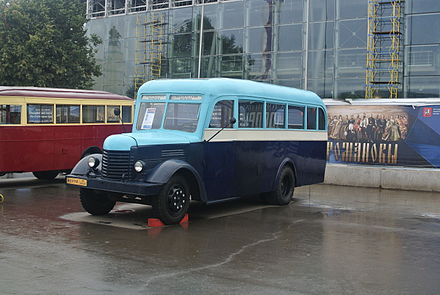
The ZIS-150 model was the base for the production of a large range of construction equipment - cranes, dump trucks, road equipment, timber trucks; special vehicles - harvesters, watering machines, fire trucks, tanks. The units and complete chassis were used to produce buses. The truck was also used in the army. Both standard flatbed trucks and chassis for special equipment went there - radio stations, degassing units, fuel tankers, etc. In 1949-57, using components and assemblies of the ZIS-150 truck, the ZIS-155 bus was produced at ZIS. At the end of 1957, it was replaced on the assembly line by the more advanced ZIL-158. Also on the ZIS-150 chassis were created tanks ATs-4-150 and ATsM-4-150 (Grabovsky Special Vehicles Plant), truck cranes AK-25 (1950), AK-3GS (1951), AK-5G (1953), fire truck PMZ-9, garbage truck MS2 (1950), watering machine PM-8 (1955) and many other special vehicles.
In particular, modifications of the ZIS-150 include:
- ZIS-150P - experimental two-axle all-wheel drive (4 × 4) vehicle (1947);
- ZIS-151 - three-axle all-wheel drive (6 × 6) vehicle (1948-1957);
- ZIS-156 - gas-cylinder (compressed gas) 3.5-ton truck (1949-1957);
- ZIS-156A - gas-cylinder (liquefied gas) 4-ton truck (1953-1957);
- ZIS-253 (UlZIS-253, NAZ-253) is an experimental 3.5-ton diesel truck for production at UlZIS and the Novosibirsk Automobile Plant. Developed independently of the ZIS at UlZIS (1947);
- DAZ-150 “Ukrainets” is an experimental 4-ton truck for production at the Dnepropetrovsk Automobile Plant. Developed independently of the ZIS at DAZ (1947-1950);
- ZIS-LTA is a half-track off-road timber transport vehicle, created in 1949 on the basis of the ZIS-5 using components and assemblies of the KT-12 skidding tractor. Subsequently it was also produced on the basis of the ZIS-21 and ZIS-150.
- ZIS-MMZ-585E - dump truck (1949-1955) with a body from the Mytishchi Machine-Building Plant; in 1952-1958 produced at the Kutaisi Automobile Plant as KAZ-585;
- ZIS-121 - truck tractor (1952-1959);
- ZIS-153 - experimental half-track vehicle (1952).
- AKZ-1 is a bus created on the basis of the ZIS-150 using the ZIS-16 body from Moscow.
